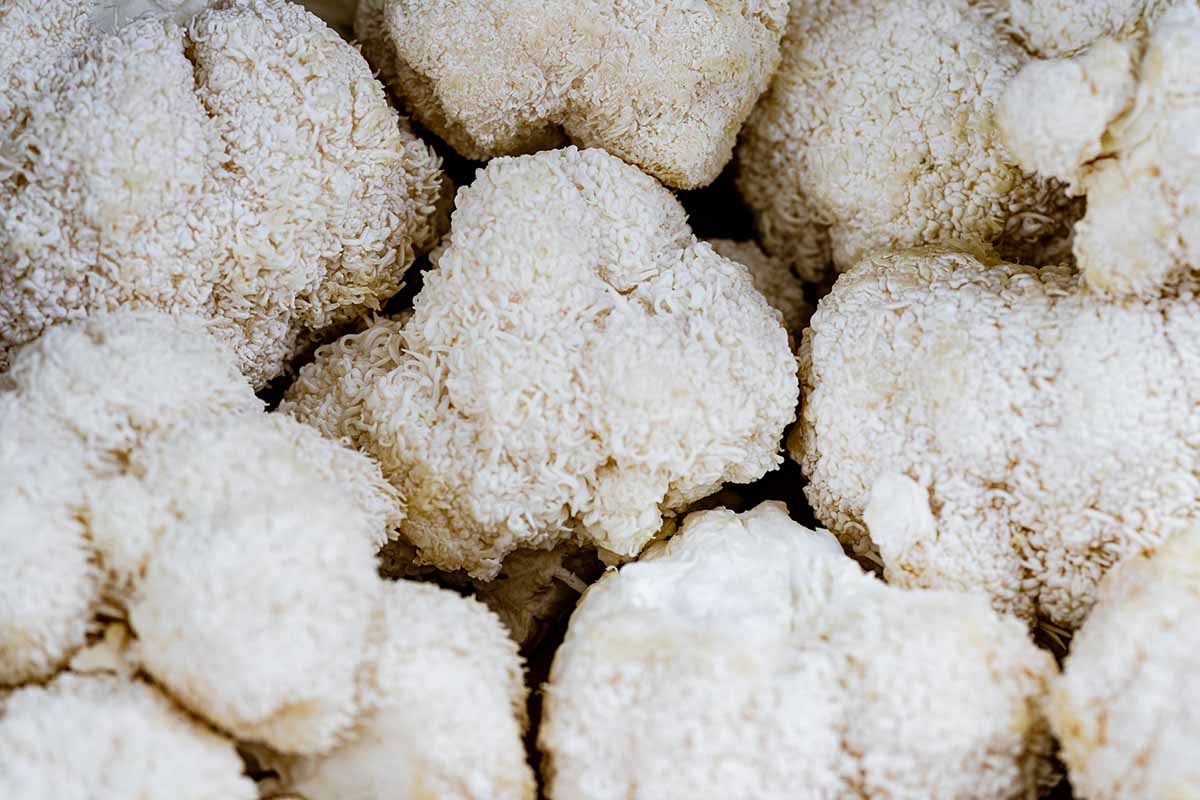Lion’s mane mushroom is one of many medicinal mushrooms that offers several health benefits. It is also a nutritious culinary ingredient as it yields a mild and slightly sweet flavor that many people compare with crab or lobster.
But while lion’s mane has been around for a very long time, its recent surge in popularity primarily stems from the nootropic benefits that it promises. [*]
Today, we will look at where to find lion’s mane mushrooms in the wild and how to grow them at home so you have instant access when you need them.

What Is Lion’s Mane Mushroom?
Lion’s mane mushroom is a unique-looking mushroom that also goes by other names such as monkey’s head mushroom, bearded tooth, or the pom pom mushroom given its shaggy appearance. Its scientific name, however, is hericium erinaceus.
The mushroom contains several bioactive substances that have been researched to be beneficial for the brain, heart, and gut.
In addition, it possesses potent anti-inflammatory, antioxidant, and immune-boosting properties to promote optimal health. [*]
Where To Find Lion’s Mane Mushrooms In The Wild?
You can find lion’s mane mushrooms throughout the Northern hemisphere including parts of North America, Europe, and Asia.
Hericium erinaceus needs a warm and humid environment along with a temperate climate to thrive, meaning that lion’s mane typically grows in late summer and fall.
When lion’s mane mushrooms grow in the wild, they will always grow on hardwood trees such as maple, oak, birch, black walnut, sycamore, and American beech trees.
Oftentimes, lion’s mane grows in wounds of dying trees or spots where branches have broken off, the bark has been damaged, or any hardwood tree that is weak enough to allow the fungus to proliferate.
The mushroom also grows on dead and decaying trees but is mostly found on live ones.
Unlike other species of mushrooms, lion’s mane is often found growing high up on trees sometimes more than 40 feet above the ground. This may make foraging for lion’s mane somewhat challenging as people mostly look for mushrooms at the ground level rather than up in the trees.
If trying to find lion’s mane mushroom in the wild seems too difficult, you can also cultivate it at home.
Growing Lion’s Mane Mushrooms At Home
It is easy and very gratifying to make lion’s mane mushroom grow at home. Just like in the wild, hericium erinaceus can grow on hardwood logs in any shady spot either indoors or outdoors, provided it gets an environment that mimics the conditions of its natural habitat.
The process isn’t hard, but may take some time for people new to mushroom growing.
Since lions mane mycelium is finer than other mushroom varieties, it may be harder to recognize when the mushroom is fully colonized and ready for the fruiting process.

How Long Does It Take Lion’s Mane To Grow At Home?
There are a few different ways to grow lions mane mushroom at home. You can use logs, bags, or containers to grow your mushrooms.
Of these, using logs to grow hericium erinaceus takes the longest time whereas bags or containers are a lot quicker.
For the log method, it can take up to one to two years after inoculation to harvest your first batch. Lion’s mane is not quick growing on logs but once the batch starts producing, you can use the same log for harvesting mushrooms for up to six years.
When using bags or containers, you can hope to harvest your lion’s mane approximately one month after inoculating your bulk substrate.
For beginners, there is the option to purchase a lion’s mane mushroom growing kit. The kit comes with an inoculated and incubated substrate which allows users to start growing their mushrooms as soon as they get their kit.
Another option is to find a lion’s mane spawn from a reputable spawn supplier and inoculate your substrate.
How To Grow Lion’s Mane Mushroom On Logs?
Using logs to grow lion’s mane mushrooms is a cost-effective technique to yield a constant and stable supply of fresh mushrooms for years.
Because the hericium species grow nicely on different types of hardwoods, it’s important to identify healthy hardwood trees when selecting logs. Decaying trees, dead wood, or trees with signs of an infection may be vulnerable to other fungal growth and won’t give you a good harvest.
Also, since the hericium species can grow to be fairly large in size, it makes sense to use logs that are three to ten inches in diameter to deliver larger-sized mushrooms.
It’s recommended to use logs from dormant trees during late summer or fall and use these up within one month from when the log was cut. This is important as logs that have been lying around for longer risk the growth of different types of fungi populating them.
Once you have chosen your logs, you need to find the lion’s mane spawn plugs.
After drilling holes in the log which would ideally be 6 inches apart, insert your spawn plugs into the holes and hammer until fully inserted.
Seal plugs with either cheese wax, beeswax, or candle wax to protect the mycelium.
Next comes the incubation, where you should store the logs under shade. Don’t forget to water the logs a couple of times a week for 10-15 minutes to keep up appropriate moisture levels.
It typically takes a year or two after inoculating before the logs yield the first harvest.
After 12 to 18 months of inoculation, the mushrooms should start to protrude from their plugged holes.
It’s important to mist the logs daily to moisten them during the fruiting process. The mushrooms are ready for harvesting once they stop growing in size and support long and thick spines.
For optimal flavor, lions mane mushroom will need to be harvested before it turned pink or brown. Picking lion’s mane mushrooms at various stages of maturity will give different textures with the younger mushrooms being denser and firmer.
How To Grow Lion’s Mane Mushrooms In Bags, Buckets, Or Containers?
You can also mimic the natural habitat of lions mane mushroom using other means than a log.
For the most part, you need a few basic items to get started such as mushroom spawn, substrate or growing medium, a fruiting block, grow bags or containers, and a spray bottle.
For lion’s mane, make sure to get hardwood pellets or hardwood chips from trees such as oak, maple, beech, or black walnut as the growing medium, as it doesn’t grow well on softwoods.
Or you can get grain spawn which contains sterilized grains inoculated with live mycelium culture. A fully colonized grain spawn is used as a starter culture for growing mushrooms.
Another option is using liquid culture which is a sterile mix of water and a few specific sugars to get the process started.
Purpose-made grow bags work as ideal substrate containers and are an essential tool for mushroom growing, whether done professionally or as a hobby.
Once you have all the materials on hand, it’s time to prepare your lion’s mane substrate. The purpose here is to provide a hydrated, nutrient-dense food source for the mycelium, closely resembling the conditions of its natural habitat.
Soaking the pellets in water for about 30 minutes breaks down and turns them into hardwood sawdust. It’s important that your substrate has the right moisture content for optimal growing conditions.
Place this mixture into a grow bag expelling as much air as possible and fold the bag according to instructions.
Once you’ve sterilized your substrate it’s time to move on to the next step which is inoculation.
Inoculation involves adding the lion’s mane mushroom spawn to the prepared substrate.
Once you have added your lions mane spawn to the substrate, mix it together and close the top of the bag with a tie or rubber band of some kind.
Place the closed bag in a dark warm area around 20 to 24 °C (68-75 °F) and leave it to incubate.
When Is Lion’s Mane Fully Colonized?
Lion’s mane mycelium is much finer when compared to other mushroom varieties, which may make it hard to identify when the mushroom is fully colonized.
In most cases, lions mane mycelium will appear wispy and thin in places but the grow kit or bag will start to feel firmer and lighten in color.
The mycelium will become visibly white as it starts to knot and form primordia. The lions mane spawn will grow, spread throughout the bag, and completely colonize the substrate. This can take around two to three weeks to fully colonize.
Once colonization is complete, place the substrate in fruiting conditions. This involves cutting holes in the bags to expose the mycelium to fresh air and placing it in a humid and shady area. Mist inside with a spray bottle several times a day to keep it healthy.
After two to three days pin heads will start to appear on the substrate which will grow into full-sized mushrooms and be ready to harvest in around 14 days.
Harvesting Lion’s Mane Mushrooms
To harvest your mushrooms, locate its base without damaging the teeth and cut along the base gently separating the mushroom from the wood it’s growing on.
Since lions mane mushrooms have a thicker base compared to other types of mushrooms, it will be helpful to use a sharp knife for an easy, clean cut without tearing the soft flesh.
Verdict
While typically found in North America, Canada, and other parts of the northern hemisphere in late summer or fall, it is possible to grow your own lion’s mane mushroom at home as well.
The convenience of homegrown mushrooms gives you instant access to add these delectable mushrooms into your meals as well as avail of their many medicinal properties.
Click below for the best nootropic stack containing the lion’s mane mushroom.






